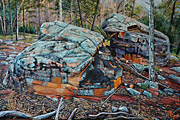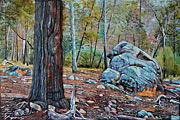Ironbark series
Australian eucalypt trees are a diverse group of 500-600 species. One way to sub-divide these species is to use bark-type. There are the gums, ashes, peppermints, stringybarks and ironbarks. Ironbarks have hard, persisant bark with deep, longitudinal furrows that break into very small polyhedrons of hard, corky texture when crumbled. Ironbark is usually dark to very dark in colour but can tone to paler colours or reds and yellows for the inner-most recent bark. Small inclusions of gum (kino) in the ironbark can also have a deep red colour and are rich in tannin, which can enhance the dark colouring.
Ironbarks are very aptly named because the bark colours do resemble ironstone or hematite (iron oxide) rock. The other analogy is with blood- the red kino veins seem to "bleed" from the bark and of course blood is iron-rich.
Australian landscape art is saturated with depictions of stately smooth-barked gum eucalypts. Other eucalypts are characteristic of certain artists such as the grayish coloured bark of Messmate Stringybark (Eucalyptus obliqua) seen in many of Frederick McCubbin's paintings from the Macedon Ranges in Victoria. However, Ironbarks are rarely ever seen in Australian landscape art. Both the dark colouring and the very rough texture make it problematic to paint. It is not a "pretty" tree and ironbark forests ocuppy some the drier, harsh sites on the western slopes of Victoria, NSW and Queensland.
The use partial 3D techniques to capture the unique ironbark texure is a feature of this series.
Killawarra Ironbarks from the Warby-Ovens National Park in Victoria and Mt Tilga Ironbarks near Condobolin NSW:
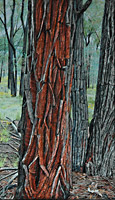
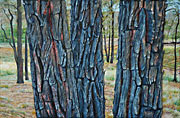
Mugga Ironbark (Eucalyptus sideroxylon) is common on the sandy slopes of Weddin Mountains National Park together with Black Cypress. There are numerous large sandstone boulders on the slopes below the cliffs that together with the older Black Cypress trunks, are partially covered with a white to pale blueish-green lichen.
Weddin Mountains Ironbarks 1 and Weddin Mountains Ironbarks 2:
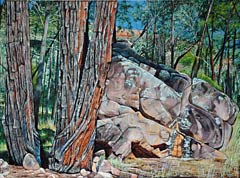
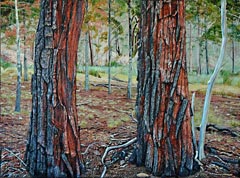
Weddin Mountains Ironbarks 2 won the 2013 Casella Art Prize at Griffith Regional Art Gallery.
Weddin Mountains Boulders 1 and Weddin Mountains Boulders 2:
Find out more about Phil's art:


